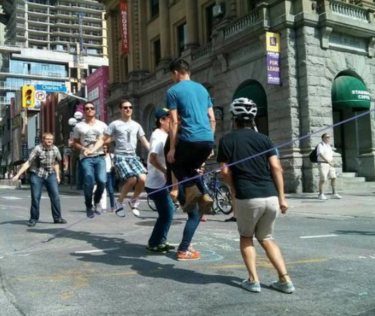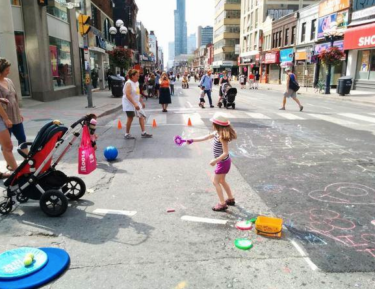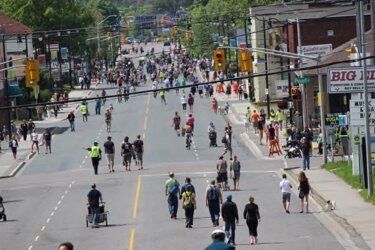Creating public places for health and cohesion by opening streets for everyone
The Doable City Reader
There is so much that can be done to make our cities happier, healthier and more prosperous places. Every day in cities around the world, citizens and city planners alike are showing us how small actions can scale up to have massive impact. And they can in your city too.
That’s what the Doable City Reader is about. In June 2014, 8 80 Cities, in collaboration with the Knight Foundation, brought 200 civic innovators from around North America together in Chicago at the Doable City Forum to share and discover methods for rapid change making. The Doable City Reader is inspired by the rich conversations amongst presenters and participants at that forum. It is a resource for any and all people who want to make change in their cities and is meant to educate, inspire and empower anyone to do so.
Less than a decade ago, the idea of a city closing its streets to vehicles and opening them for the public to enjoy car-free every Sunday was considered radical. In 2007, only about 10 North American cities dared to have such programs — known as Open Streets in North America and Ciclovías in Latin America — that temporarily turn streets into paved parks where people can run, walk, cycle or participate in exercise programs. Today, there are over 100 on the continent, from megacities like New York City and Los Angeles to small towns. And each year the number grows.
Helping cities get Open Streets programs off the ground is a big part of what 8 80 Cities does, because it is something that any city can do immediately. Executive Director Gil Penalosa, who founded the Open Streets movement in Bogotá, Colombia in the early 2000s, says that he originally took his inspiration from Frederick Law Olmsted, who created New York City’s Central Park for the purpose of bringing communities together — a principle that Penalosa continues to see at the heart of Open Streets programs.
“One hundred and sixty years ago he was writing how in New York, everybody hated everybody — the rich and the poor and the immigrants and the blacks and the whites — and he said, ‘Look, people don’t know each other! They don’t live in the same buildings, their children don’t go to the same schools, when they get sick they don’t go to the same doctor! We need to find a place where people can meet each other as equals.’ One of the things I find so exciting about the Ciclovía is that it’s like an exercise in social integration. It’s like a Central Park, except that it’s something that every city around the world can have,” he said.

In part, Open Streets are a means to an end: a way to help people envision their cities and streets differently, to take ownership of them as public places and experience their cities differently. But there’s more to it than that. Many cities pursue Open Streets for the sake of other goals, most notably public health. And, studies show, they have good reason. As 8 80 Cities program director Emily Monroe points out, in cities where Open Streets happen regularly, they can be a goal in and of themselves for this purpose.
“I would challenge anybody to show us a recreational program that has the level of participation like the Ciclovías in Bogotá and Guadalajara. Every single Sunday you have people out being physically active for between one and two hours. That’s a million people every Sunday participating in an exercise class. There’s nothing I can think of that works like that. I think that once they reach a certain point, a certain frequency, a certain length, a certain amount of participation, that they do act as an end in themselves.”

As written in C3’s recent meta-review “The Benefits of Regular Walking for Health”:
“A review of 38 Ciclovías found that they have real potential for positive public health outcomes, summarizing the evidence to date — which is limited, but encouraging. For example, one study found an estimated 41 per cent of Ciclovía participants in Bogotá took part for more than three hours (including about a third walking or running, and about half the participants cycling). A study of health‐related quality of life measures found that adults participating in at least one day of the Ciclovía each month scored higher than those who did not participate (even after adjusting for sociodemographic and other factors), and one study showed that levels of particulate matter along a section of Bogota’s Ciclovía street was 13 times higher on a weekday than on Sunday (the day of the Ciclovía). The health benefits of the Ciclovías have recently been evaluated — with the cost-benefit ratio for health benefit from physical activity estimated at 3.23-4.26 for Bogotá, 1.83 for Medellín (also in Colombia), 1.02-1.23 for Guadalajara (Mexico) and 2.32 for San Francisco.”
Just because any city can have an Open Streets program doesn’t necessarily mean it’s easy. Like with any change, Munroe says, getting the political will and support of the business community can be tough and the logistics of implementation daunting. But, she notes, it’s been proven again and again to be possible, pointing out that Open Streets Toronto — a program administered in part by 8 80 Cities — happened under the city’s most blatantly unsupportive and right-wing mayor, Rob Ford, thanks in large part to the extreme support of several business improvement associations.
Penalosa says that many of the programs that currently exist could still stand to be improved. “Too many people see it as an event. It’s not an event, it’s really a program. It’s not something you do once a year, like if it was Canada Day or the Fourth of July in the States, but it’s something you should be doing every Sunday,” he said. But the resources are increasingly available for cities to make this happen.

In 2012 the Open Streets Project produced a report on Open Streets projects throughout North America. It provides case studies and background to the Open Streets movement in North America. This spring 8 80 Cities will release a comprehensive toolkit that will help communities implement programs in their own cities.
